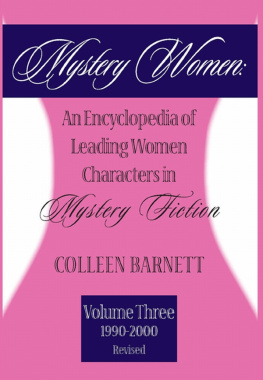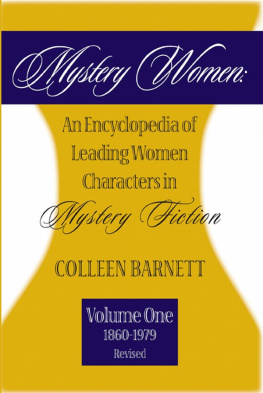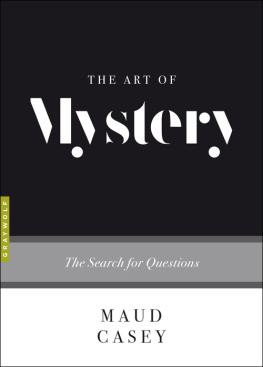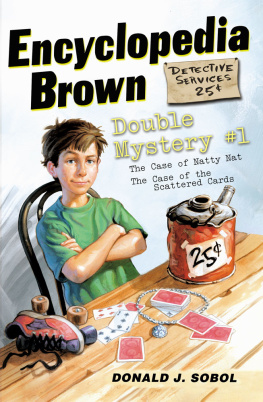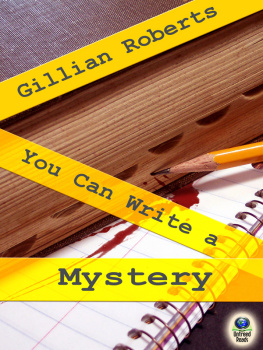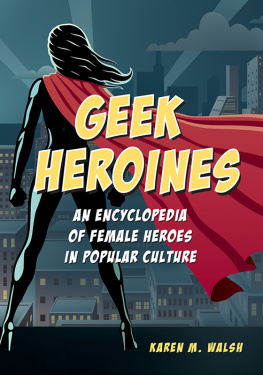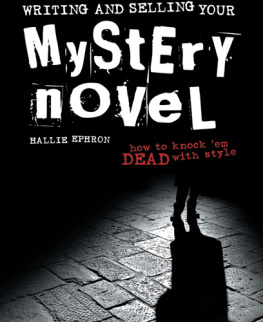Mystery Women
Mystery Women
An Encyclopedia of Leading Women Characters in Mystery Fiction
Vol. III (1990-1999)
Revised
Colleen Barnett
Poisoned Pen Press

Copyright 2010 by Colleen Barnett
Revised Edition
Library of Congress Catalog Card Number: 2001086357
ISBN: 9781615950102 ePub
All rights reserved. No part of this publication may be reproduced, stored in, or introduced into a retrieval system, or transmitted in any form, or by any means (electronic, mechanical, photocopying, recording, or otherwise) without the prior written permission of both the copyright owner and the publisher of this book.
Poisoned Pen Press
6962 E. First Ave. Ste 103
Scottsdale, AZ 85251
www.poisonedpenpress.com
This book is dedicated to mystery fans, beginning with the 6th, 7th, and 8th graders at St. Josephs Academy in Green Bay, Wisconsin (where I attended grade school and high school) who shared my passion for Nancy Drew and Judy Bolton. The series has been written to share my discoveries. I hope that readers will correct my flaws (in a kindly fashion) and make me aware of new authors and new sleuths.
What fun reading can be!
and to the additions to our family, Jean and Lucee, Trina, Joshua and Ainslee, Metsu and Abebu. What joy they have brought.
In Memoriam
John E. Barnett
(1923-2004)
Table of Contents
The Tate Sisters:
Like other fictional characters, female sleuths may live in the past or the future. They may represent current times with some level of reality or shape their settings to suit an agenda. There are audiences for both realism and escapism in the mystery novel. It is interesting, however, to compare the fictional world of the mystery sleuth with the world in which readers live. Of course, mystery readers do not share one simplistic world. They live in urban, suburban, and rural areas, as do the female heroines in the books they read. They may choose a book because it has a familiar background or because it takes them to places they long to visit. Readers may be rich or poor; young or old; conservative or liberal. So are the heroines. What incredible choices there are today in mystery series! This three-volume encyclopedia of women characters in the mystery novel is like a gigantic menu. Like a menu, the descriptions of the items that are provided are subjective.
Volume 3 of Mystery Women as currently updated adds an additional 42 sleuths to the 500 plus who were covered in the initial Volume 3. These are more recently discovered sleuths who were introduced during the period from January 1, 1990 to December 31, 1999. This total almost doubles the number of sleuths introduced in the 1980s (298 of whom were covered in Volume 2) and easily exceeded the 347 series (and some outstanding individuals) described in Volume 1, which covered a 130-year period from 1860-1979. It also includes updates on those individuals covered in the first edition; changes in status, short reviews of books published since the first edition through December 31, 2008.
There are discernable reasons for the explosion in mystery series with female sleuths. The mystery novel has gone beyond the puzzle aspect to embrace issues that directly affect the lives of contemporary women. Many, but not all of the narratives, have serious themes such as the pressures faced by career women with children and/or spouses; the environmental consequences of industrial expansion; and the evils of child abuse, incest, and spousal abuse that were always there, but of which we are now more aware. Not everyone wants to be educated when they pick up a mystery novel, but if well done, the social message can be delivered as part of an exciting investigation. Many women readers have turned from the traditional novel to the mystery novel to explore their own feelings about the world they live in.
Women buy more mysteries than men; read more mysteries than men; and female sleuths dominate the world of the mystery author. Some male writers have written excellent series featuring women under their own names; others use initials or pseudonyms. Frank King has had four such series; one, Sally Tepper under his own name; three as Lydia Adamson; i.e. Alice Nestleton, Deirdre Quinn Nightingale, and Lucy Wayles. Other male authors have both female and male sleuth series and utilize the female in supporting roles in books identified as featuring the male.
The traditional mystery still exists. The puzzle mystery (see by Parnell Hall) and the cozies proliferate. Familiar genres like the police procedural and the hard-boiled private detective are there, but now the primary character, or at least a significant member of the ensemble, will be a woman. She may have talents and skills that complement those of the traditional male detective. Andy Sipowicz of NYPD Blue would meet his match in Jane Tennison.
The number of females with major roles in police procedurals exceeds 75 in this decade. That could not have been realistic before the full impact of the Equal Employment Opportunity Act of the 1960s. Add in others who work in association with police departments (forensic specialists, bloodhound trainers, bail skip tracers and parole officers); and well over one hundred private investigators. The number of female attorneys is not at all unrealistic. Most current law school classes have close to 50 percent women students.
However, the menu includes many sub-genres tailored for women readers. The antique dealers, the caterers, operators of hotels and bed & breakfasts, quilters and crafters each have their own constituency. Their popularity may reflect the trend back to more traditional female roles as explored by Karine Moe and Dianna Shandy in Glass Ceilings and 100-Hour Couples and by Gail Collins in Americas Women and When Everything Changed. All three of these books combined statistical material and personal interviews indicating that some women chose to opt-out of full-time, high energy careers to place a greater emphasis on family. These changes included: part-time work when the employer agreed (although it may have meant reduced salaries); early retirement, and perhaps a change in occupation to managing a shop, a Bed and Breakfast, or some similar business which allowed more flexibility as to schedules and hours worked.
The changes in style of many female sleuths also reflect legal, political, and economic changes. Females, according to Collins, (1) now own one-third of U.S. businesses; (2) women are earning 55% of all college degrees including more than half recently granted in dental and veterinary schools; close to that amount in medical and law schools; and provide 47% of the current workforce. Those numbers may well be changed by the profound recession of 2008-2009 and later. The occupations dominated by men, such as construction, have suffered more seriously than those in which women have secured parity. This has lead to an increase in marriages where the wife is either the primary breadwinner or, at least for a time, the only one.
Marriage and Children
A simple overview of the sleuths covered in Volume 3 indicated that the majority were women in mid-life, the thirties and forties. Those are years when members of the general female population are trying to make it to their sons or daughters basketball games, attending band concerts, and preparing for summer camp, school graduations and weddings. This is a great change from the early days of the mystery novel that focused on the elderly spinster and the young unmarried woman.
Many of the current sleuths disdain marriage or consider it a short-term contract, voidable at will. The number of those sleuths identified as single with lover exceeds that of those termed merely single. There are happily married couples, to be sure, but usually they are to be found among those for whom murders are not a professional interest. The pressures upon police officers as shown in the high divorce rate makes that understandable.

